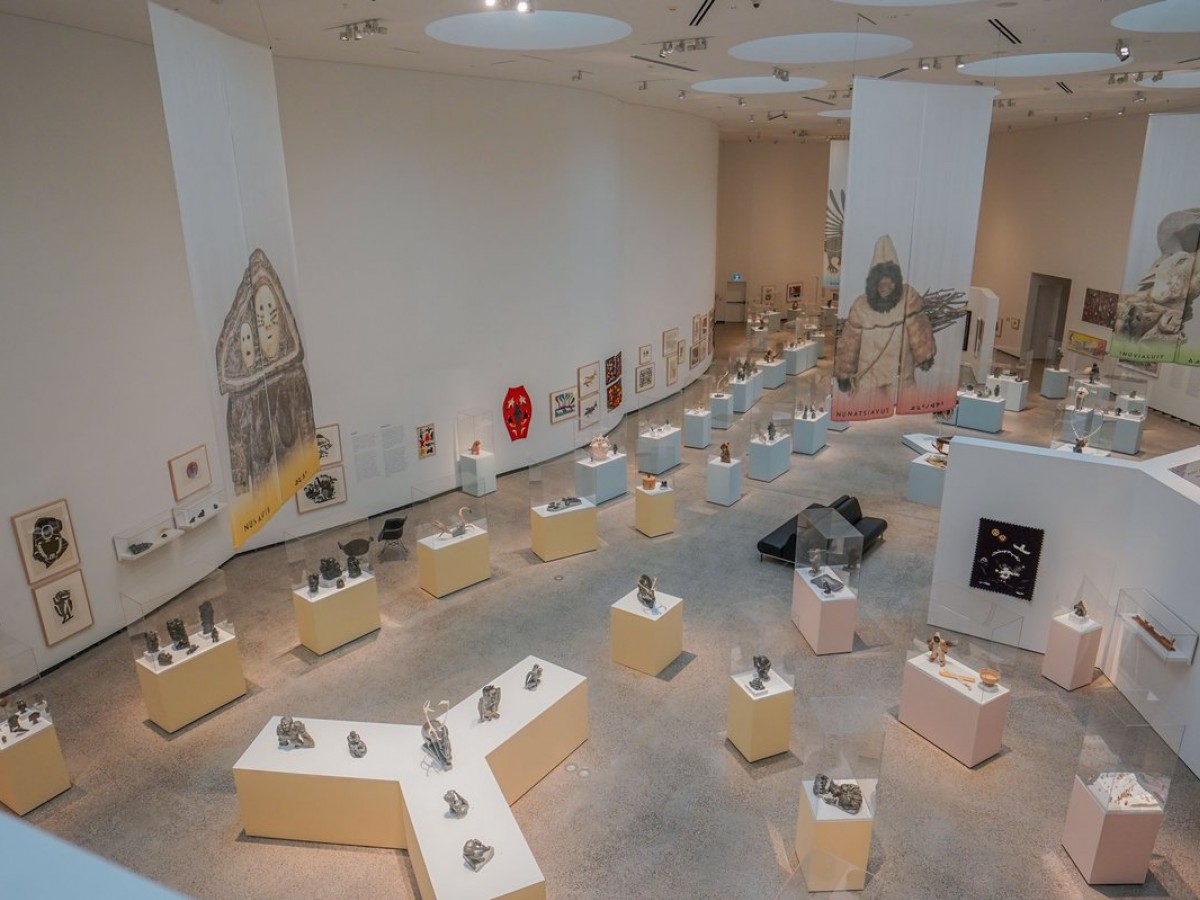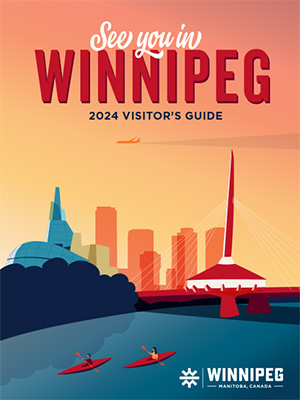Indigenous-led cultural experiences and businesses are found throughout Winnipeg, a city that is home to Canada's largest urban Indigenous population.
From murals and big art pieces to restaurants and tours, experiences, culutral attractions and centres offer distinctive experiences for visitors, while many also do not shy away from exposing centuries of oppression.
The below experiences provide a glimmer of insight into the rich Indigenous cultures in Winnipeg and across Canada as we all work toward reconciliation.
Learn Indigenous History
- Dig Deeper at The Forks National Historic Site
- Ponder Rooster Kettle Town
The Forks National Historic Site
The Forks is both Manitoba's most-visited tourism site and one of the most historically important places in Western Canada. Sites such as the Oodena Celebration Circle, a three-metre deep bowl once filled with artifact-rich soil, pays striking homage to the Indigenous People of the area who used the spot as a gathering place for 6,000 years.
Take in Niimaamaa, a big, bold stylized sculpture of a pregnant woman located within Niizhoziibean, The Forks' Indigenous-led grounds for gathering and expression. This 30-foot outdoor piece by artists KC Adams, Jaimie Isaac and Val Vint represents motherhood, Mother Earth and new beginnings. Niimaamaa means “my mother” to Cree, Ojibway, and Métis speakers. Niizhoziibean also houses a space for drum circles and ceremony, native plants, and signage in Cree and Ojibway.
Walk through the history of Indigenous People in Manitoba through stories and legends as you take in these monuments and more on a 90-minute self-guided audio tour. The recording features numerous locals including Elders Clarence and Barbara Nepinak, who named Niizhoziibean (which means Two Rivers in Ojibway).
Rooster Town Kettle
“They gave everyone $50 and then they kicked them out. Then they built a big mall and the property developers got to make money off of it.” - Lawrie Barkwell, Louis Riel Institute, quoted in The Uniter
A five-metre tea kettle in the middle of Winnipeg is big enough to hold water for 250 people, making a statement about the lack of clean water in Rooster Town in the early 1900s and an ongoing problem some Indigenous communities still face today. At the Beaumont Station on Winnipeg’s Southwest Transitway, the kettle is hard to miss.
Rooster Town Kettle acknowledges that a Métis community housing 250 people once stood here on the outskirts of Winnipeg from 1901 to 1961. As plans for Fort Rouge took shape, the families were expropriated from their boxcar lumber homes by the City of Winnipeg. Outlier Métis communities were common in parts of Canada, but are relatively unknown — or forgotten — shards of history. The kettle, designed by Métis artist Ian August, denotes the strong sense of community in Métis households, where hot tea and a visit were always on offer. The town’s name likely came from seasonal railway workers who roosted there.
See Indigenous Art
- Star Blanket Murals
- Urban Shaman
- WAG-Qaumajuq
Over the last few years, initiatives have contributed to Indigenizing the city with large scale, public art created by Indigenous artists.
Star Blanket and other murals
At least five buildings in Winnipeg, including one at 511 Ellice, appear to be blanketed fittingly by Star Blanket murals. To learn more about this and other stunning pieces by Métis artist Kenneth Lavallee and others, visit the Star Blanket Project.
Some murals, like the one on a railway pass on Winnipeg’s Portage Avenue, serve a higher purpose. Tom Andrich’s mural shows the faces of 10 missing and murdered Indigenous women.
Read more on murals here, including The Fancy Shawl Dancers on the Sutherland Hotel and the Louis Riel mural on the side of Nonsuch Brewing Company.
Urban Shaman – Outdoor murals feel very grassrooted, but don’t miss the city’s indoor galleries. One of the foremost venues for Indigenous art in Canada, Urban Shaman presents contemporary Indigenous art in its gallery in the Exchange District.
While Qaumajuq, the Winnipeg Art Gallery’s award-winning $65-million Inuit art centre, can be seen right on the cover of TIME magazine’s World’s Greatest Places 2021 issue, you really must witness it in person. This gorgeous building pays homage to the Arctic landscape with a façade and galleries that flow like snow drifts, brilliantly presenting the world’s largest collection of contemporary Inuit art. The opening exhibit INUA was created by an all-Inuit curatorial team, while the WAG is constantly working with an Indigenous Advisory Circle and Indigenous Knowledge Keepers in all aspects. The WAG itself houses an internationally acclaimed collection of more than 27,000 works, spanning the Renaissance to modern Canadian and Manitoba-centric pieces, with a particular emphasis on contemporary Indigenous artists.
Shop Indigenous
- Visit Teekca’s Aboriginal Boutique
- Anne Mulaire Fashion Designer
Teekca’s Aboriginal Boutique at The Forks – Teekca's has a wide selection of Indigenous-made items, from popular beaded moose and cowhide moccasins to star blankets and teas. Dream catchers, bear oil products, caribou tufting, silver and southwest turquoise jewellery, soapstone carvings and more unique items are available for purchase.
Anne Mulaire – Anne is an award-winning Canadian fashion designer of French Métis descent with a desire to empower the women who wear her clothing. Born in Saint-Boniface and raised to embrace her Anishinaabe and French heritage, Andréanne Mulaire Dandeneau is the great-great-great granddaughter of Catherine Mulaire, who was born in 1843, the daughter of a Voyageur and the first rural Métis teacher in the Red River Settlement.
Roam the shop on the third floor of 421 Mulvey Ave East and feast your eyes on beaded Fléchée belts, Spirit of the North bamboo bumwarmers and stunning Jean Louis blazers and embroidered blouses in her Heritage collection.
Eat Indigenous Food
Feast Café Bistro fills a delicious gap in the absence of Indigenous eateries across Canada. Manitoba pickerel, Manitoba bison ribs or slow-roasted bison pair nicely with hot traditional bannock, a quick flatbread.
From Peguis First Nation, chef and owner Christa Bruneau-Guenther wants visitors to experience modern dishes rooted in traditional First Nation foods at her West End eatery Feast Café Bistro. Christa's recipes have been featured in Canadian Living, Chatelaine and on Food Network Canada.
In the past two years alone, five new Indigenous restaurants and concepts have opened in Winnipeg, greatly expanding our offerings to include a gorgeous new restaurant space with a Cree female chef at the helm; a food truck with a focus on Ojibway fusion food; two pizza joints that utilize bannock, and a Franco-Métis farm-to-table space that overlooks all of downtown on the Red River. Find them all here.

